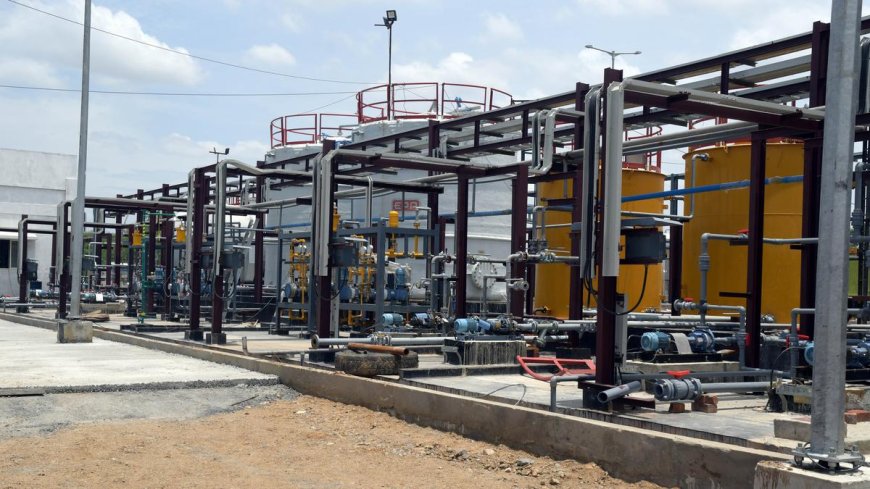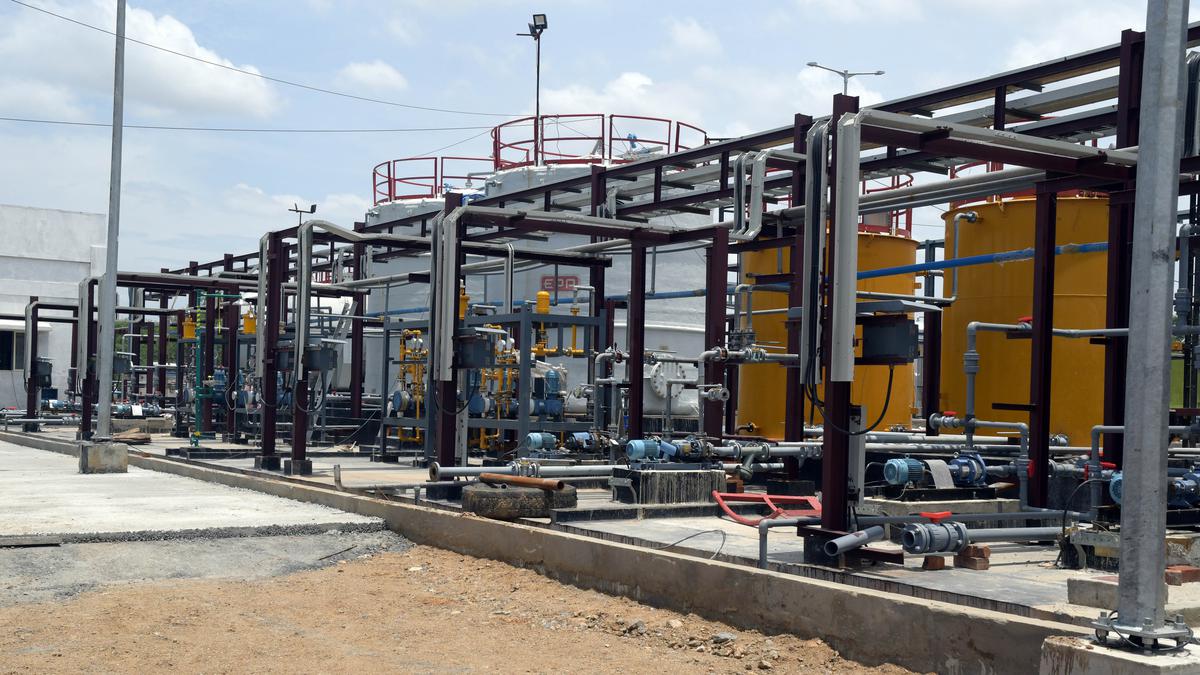Chennai city waterways may carry cleaner flow with revamped sewage treatment plants set to produce better quality reclaimed water
Chennai city waterways may carry cleaner flow with revamped sewage treatment plants set to produce better quality reclaimed water The Hindu

Chennai Metrowater to Retrofit Sewage Treatment Plants for Cleaner Waterways

City waterways may carry cleaner flow as Chennai Metrowater is set to complete retrofitting work in existing sewage treatment plants in a few months.
The water agency is refurbishing the existing sewage treatment plants that were added to the network during various years. Officials of the Metrowater said the treatment technology in seven sewage treatment plants across the city was being modified to suit the new quality norms.
The oldest one with a capacity to treat 23 million litres a day of sewage was built in Nesapakkam in 1974. Spread over 45 acres, the Nesapakkam premises has four plants, including the recently commissioned 50 mld tertiary treatment plant. The plants together treat nearly 94 mld of sewage received from various zones such as Kodambakkam and Valasaravakkam.
Work in five of the seven STPs would be completed by December this year. The project in 110 mld Kodungaiyur plant and 120 mld Koyambedu STP would be finished by March next year.
Work is in progress to upgrade the facilities in Kodungaiyur and Koyambedu plants with Moving Bed Biofilm Reactor (MBBR) technology that has effective biological treatment compared to the conventional activated sludge process adopted now in the STPs.
The MBBR technology was adopted in the existing plants as it was found to be best suited to partially dismantle and replace some units with improved technology to comply with quality standards, officials said.
The operation of the plants and quality of treated wastewater is monitored using SCADA (supervisory control and data acquisition) online system by various agencies. The project aims to produce better quality reclaimed water. The biochemical oxygen and the total suspended solids that determine the quality of treated sewage would be reduced to less than 10 mg a litre and 20 mg a litre respectively. In Nesapakkam plant, BOD level has been reduced to less than 7 mg/litre, officials said.
Citing a recent signing of a memorandum of understanding with representatives of German Water Partnership, officials said the 23-mld plant in Nesapakkam that has entered its 50th year would be renovated using German technology. A study on the operation and technology and replicable model with better efficiency would be done in the first phase. The plant’s capacity may be enhanced to use reclaimed water.
Work would be taken up in three or four months with the concurrence of Department of Economic Affairs for funding. Once the project to strengthen the sewerage treatment infrastructure is completed, Metrowater’s sewage treatment capacity is expected to increase from the present 745 mld to 1,082 mld, officials said.
Sustainable Development Goals (SDGs)
- Goal 6: Clean Water and Sanitation – The retrofitting of sewage treatment plants in Chennai aligns with SDG 6 by improving the quality of treated wastewater and ensuring cleaner waterways in the city.
- Goal 9: Industry, Innovation, and Infrastructure – The adoption of Moving Bed Biofilm Reactor (MBBR) technology in the sewage treatment plants demonstrates innovation and improvement in infrastructure for more effective biological treatment.
- Goal 11: Sustainable Cities and Communities – The retrofitting project aims to enhance the sewerage treatment infrastructure in Chennai, contributing to the development of sustainable cities and communities.
Conclusion
The retrofitting work in Chennai Metrowater’s sewage treatment plants is expected to result in cleaner waterways and improved quality of treated wastewater. By adopting innovative technologies and upgrading the facilities, the project aligns with the Sustainable Development Goals, particularly SDG 6, SDG 9, and SDG 11. Once completed, the increased sewage treatment capacity will contribute to a more sustainable and resilient water management system in Chennai.
SDGs, Targets, and Indicators
-
SDG 6: Clean Water and Sanitation
- Target 6.3: By 2030, improve water quality by reducing pollution, eliminating dumping and minimizing release of hazardous chemicals and materials, halving the proportion of untreated wastewater, and increasing recycling and safe reuse globally.
- Indicator 6.3.2: Proportion of bodies of water with good ambient water quality.
- Indicator 6.3.3: Proportion of wastewater safely treated.
-
SDG 9: Industry, Innovation, and Infrastructure
- Target 9.4: By 2030, upgrade infrastructure and retrofit industries to make them sustainable, with increased resource-use efficiency and greater adoption of clean and environmentally sound technologies and industrial processes.
- Indicator 9.4.1: CO2 emission per unit of value added.
Analysis
-
SDG 6: Clean Water and Sanitation
The article discusses the retrofitting work in existing sewage treatment plants in Chennai to improve water quality. This aligns with SDG 6, which aims to ensure clean water and sanitation for all.
- The article mentions that the treatment technology in seven sewage treatment plants is being modified to suit new quality norms. This addresses Target 6.3, which focuses on improving water quality by reducing pollution and increasing safe reuse of wastewater.
- The article also mentions that the project aims to produce better quality reclaimed water by reducing biochemical oxygen demand (BOD) and total suspended solids (TSS) levels. These indicators, BOD and TSS, can be used to measure progress towards Target 6.3.3, which aims to increase the proportion of wastewater safely treated.
-
SDG 9: Industry, Innovation, and Infrastructure
The article highlights the use of Moving Bed Biofilm Reactor (MBBR) technology in upgrading the sewage treatment plants. This aligns with SDG 9, which focuses on promoting sustainable industry, innovation, and infrastructure.
- The article mentions that the facilities in Kodungaiyur and Koyambedu plants are being upgraded with MBBR technology, which is a clean and environmentally sound technology. This addresses Target 9.4, which aims to upgrade infrastructure and retrofit industries with sustainable technologies.
- The article does not explicitly mention any indicators related to SDG 9. However, the use of MBBR technology can contribute to reducing CO2 emissions per unit of value added, which is the indicator for Target 9.4.1.
Table: SDGs, Targets, and Indicators
| SDGs | Targets | Indicators |
|---|---|---|
| SDG 6: Clean Water and Sanitation | Target 6.3: By 2030, improve water quality by reducing pollution, eliminating dumping and minimizing release of hazardous chemicals and materials, halving the proportion of untreated wastewater, and increasing recycling and safe reuse globally. | Indicator 6.3.2: Proportion of bodies of water with good ambient water quality. Indicator 6.3.3: Proportion of wastewater safely treated. |
| SDG 9: Industry, Innovation, and Infrastructure | Target 9.4: By 2030, upgrade infrastructure and retrofit industries to make them sustainable, with increased resource-use efficiency and greater adoption of clean and environmentally sound technologies and industrial processes. | Indicator 9.4.1: CO2 emission per unit of value added. |
Behold! This splendid article springs forth from the wellspring of knowledge, shaped by a wondrous proprietary AI technology that delved into a vast ocean of data, illuminating the path towards the Sustainable Development Goals. Remember that all rights are reserved by SDG Investors LLC, empowering us to champion progress together.
Source: thehindu.com

Join us, as fellow seekers of change, on a transformative journey at https://sdgtalks.ai/welcome, where you can become a member and actively contribute to shaping a brighter future.







